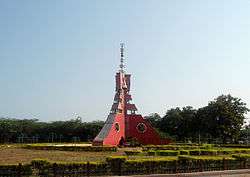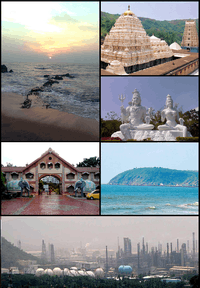Visakhapatnam Steel Plant
|
| |
| Public Sector Enterprise | |
| Industry | Steel |
| Founded | 1971 |
| Headquarters | Visakhapatnam, India |
Key people | P. Madhusudan, Chairman cum Managing Director |
| Products | Plain rounds, re-bars, squares, flats, billets, pig iron, plain wire rods In Coils I, Plain Wire Rods In Coils II |
| Revenue |
|
| Website |
www |
Visakhapatnam Steel Plant, popularly known as Vizag Steel (Telugu: విశాఖ ఉక్కు కర్మాగారం), is an integrated steel producer in Visakhapatnam, India built using German and Soviet technology. Its products have been rated the best in the world market. The company has grown from a loss-making industry to 3-billion-dollar turnover company registering a growth of 203.6% in just four years. Vizag Steel Plant was conferred Navratna status on 17 November 2010.[1] Founded in 1971, the company focuses on producing value-added steel, with 214,000 tonnes produced in August 2010, out of 252,000 tonnes total of salable steel produced.[2] It is the largest single site plant in India and Asia minor (or south and east Asia combined).
History

On 17 April 1970, the then Prime Minister of India, the late Indira Gandhi, announced the government's decision in the Parliament to establish a steel plant at Visakhapatnam. Planning started by appointing site selection committee in June 1970 and subsequently the committee's report was approved. On 20 January 1971, Gandhi laid the foundation stone of the plant. Consultants were appointed in February 1971, and feasibility reports were submitted in 1972. The first block of land was taken over on 7 April 1974. M/s M.N. Dastur & Co was appointed as the consultants for preparing the detailed project report in April 1975 and in October 1977 they submitted a proposal for 3.4 Mtpa of liquid steel. With the offer for assistance from the government of the erstwhile USSR, a revised project evolved. A detailed project report for a plant with a capacity of 3.4 Mtpa was prepared by M/s M.N. Dastur & Co in November 1980. In February 1981, a contract was signed with the USSR for the preparation of working drawings of coke ovens, blast furnace and sinter plant. The blast furnace foundation was laid, with first mass concreting, in January 1982. The construction of the local township was also started at the same time.
In the 1970s, Kurupam Zamindars donated 6,000 acres of land for Vizag Steel Plant. A new company Rashtriya Ispat Nigam Limited (RINL) was formed on 18 February 1982. Visakhapatnam Steel Plant was separated from SAIL and RINL was made the corporate entity of Visakhapatnam Steel Plant in April 1982.
Vizag Steel Plant is the only Indian shore-based steel plant and is situated on 33,000 acres (13,000 ha), and is poised to expand to produce up to 20 MT in a single campus. Turnover in 2011-2012 was Rs 14,457 crores. On 20 May 2009, Prime Minister Manmohan Singh launched the expansion project of Visakhapatnam Steel Plant from a capacity of 3.6 MT to 6.3 MT at a cost of Rs. 8,692 crores. But the investment was revised to 14,489 crores with the following classification:
- Expenditure for the financial year 2009-10 Rs 1840 crores.
- Rs 5883 crores since inception of the project.
- Total commitment, including enabling works, steel procurement, consultancy, spares, etc. is Rs 11591 crores as of 25 March 2010.
The expansion project is expected to become functional by 2012. It has been rated "the best place to work in India" for consecutive five years.
Currently, GOI owns 100 % shares of RINL VIZAG steel plant.
Infrastructure
- Coke Ovens and Coal Chemical Plant
- Sinter plant
- Blast furnace
- Calcining and Refractory Material Plant
- Steel Melt Shop and Continuous Casting
- Light and Medium Merchant Mill
- Medium Merchant and Structural Mill
- Wire rod mill
- Steel melt shop
- THERMAL power plant
Coke ovens and coal chemical plants
Functions
- Coke Dry Cooling Plant
- Coke Chemical Plant (CCP)
- Gas Condensation Section
- Ammonium Sulphate Section
- Final Gas Cooling and Napthelene Washing
- Benzol Recovery
- Dry Purification Unit
- Gas Bleeder
- Tar Distillation Plant
From the store yard, the coking coal is sent to foreign material removing section to remove foreign matter of above 150 mm size. Iron traps for ferromagnetic articles and cylindrical screens are provided for this. 16 nos of bins each 800 tonnes capacity are provided along with continuous action feeders of up to 100 tonnes per hour capacity each. After blending the material is crushed to take care of petrographic non-uniformity, high hardness and mineral content of crushed and blended coal (74-78% of 3mm size is conveyed to two coal towers each of 4000 T capacity. Weigh bridges are provided under coal towers to weigh the coal charge. system of pneumatic blow down of blend is provided in the coal tower to take care of jamming of coal.
Battery

The prepared coal charge in the coal tower is drawn by a charging car on the top of the batteries and charged into the ovens as per sequence. The charged coal is gradually heated by the heating wall of the oven in the absence of air to attain a temperature of 1000°-1050 °C at the central axis of the coke mass toward the end of coking period. the coking period is generally specified between 16 hrs and 19 hrs depending on oven condition and production requirement. the volatile matter of coal liberated during carbonization is collected in gas collecting mains in the form of raw coke oven gas passing through stand pipes and direct contact cooling with ammonia liquor spray. The gas cooled from 800 °C is drawn to coal chemical plant by exhauster. The residual coke is pushed out of the oven by pusher car through a guide into coke bucket. The red hot coke is taken to coke dry cooling plant for cooling.There are 3 batteries, each having 67 ovens each. Each oven can hold 32 tons of dry coal charge. The volumetric capacity of each oven is 41.6 cum the heat for carbonization is supplied by under firing of coke oven gas having CV of 4200 Kcal/Nm3 of mixture of BF gas & CO gas having 900 Kcal/Nm3. The heating system of batteries is of under jet, compound type having twin-heating flues with re-circulation of waste gases.
Accidents
- On 13 June 2012, 19 people died during a trial run of recently commissioned oxygen plant, due to a massive explosion in the plant.[3] Union Steel Minister Beni Prasad Verma visited and announced ₹20 lakh (US$30,000) Ex gratia to each person.
- In June 2014, two engineers were fatally injured in a suspected case of Carbon monoxide poisoning.[4]
- On 7 Nov 2014, a minor explosion occurred in the Blast Furnace II but there were no casualties.[5]
- In February 2015, an assistant general manager was involved in a fatal accident when he fell into a rotating drum.[6]
References
- ↑ "RINL is now a Navratna". business-standard.com. Retrieved 6 February 2012.
- ↑ "Vizag Steel production up". Business Standard. 4 September 2010. Retrieved 15 September 2010.
- ↑ "Massive explosion and fire in Vizag Steel plant, 16 dead, many injured". 13 June 2012.
- ↑ "Two engineers killed in accident at Vizag Steel Plant". Business Standard. 16 June 2014.
- ↑ "Minor explosion in Vizag Steel Plant blast furnace". The Hindu. 7 Nov 2014.
- ↑ Patnaik, Santosh (12 Feb 2015). "Vizag Steel Plant official dies in industrial mishap". The Hindu.
External links
| Wikimedia Commons has media related to Visakhapatnam Steel Plant. |
